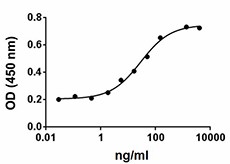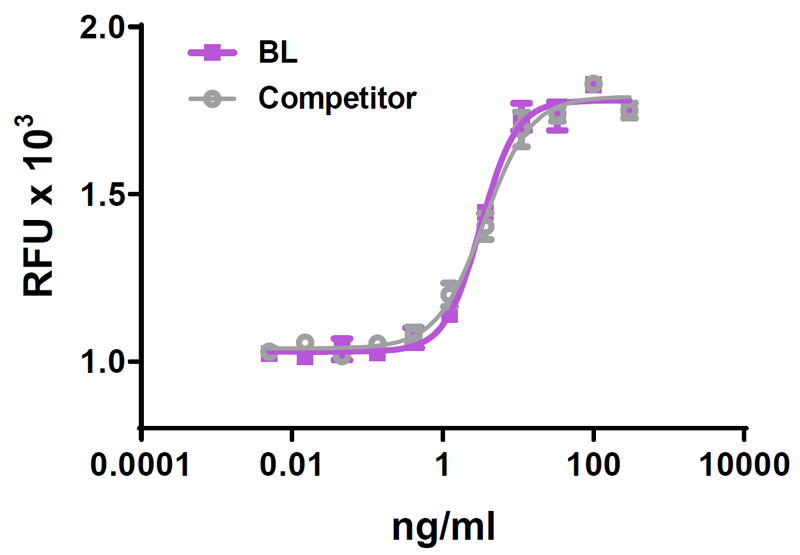- Regulatory Status
- RUO
- Other Names
- Interferon λ2, IFN-λ2, Interferon lambda 2
- Ave. Rating
- Submit a Review
- Product Citations
- publications

-
Human IL-28A induces MMP-9 in human bladder carcinoma 5637 cell line.
| Cat # | Size | Price | Quantity Check Availability | Save | ||
|---|---|---|---|---|---|---|
| 754202 | 10 µg | $147 | ||||
Select size of product is eligible for a 40% discount! Promotion valid until December 31, 2024. Exclusions apply. To view full promotion terms and conditions or to contact your local BioLegend representative to receive a quote, visit our webpage.
Human IL-28A was initially identified in conjunction with IL-28B and IL-29 from human genomic sequences. They are distantly related to type I interferons (IFNs) and the IL-10 family. Like the IL-10 gene family, IL-28A, IL-28B, and IL-29 contain multiples exons. IL-28A and IL-28B share 96% amino acid identity, while IL-29 has 81% homology to IL-28A and IL-28B. Similar to type I IFNs, these three cytokines are induced by viral infections and possess antiviral activity. Thus, this family of cytokines is called lambda-interferons or type III interferons. IL-28/29 represents an evolutionary link between type I IFNs and the IL-10 family. The IL-28/29 cytokines bind to a heterodimeric receptor formed by IL-28Rα and IL-10Rβ, which is also part of the receptors for IL-10, IL-22, and IL-26. IL-10Rβ is widely expressed and IL-28Rα is restricted to epithelium like tissues (hepatocytes) and myeloid lineage cells such as dendritic cells and macrophages. IL-28A inhibits hepatitis C virus (HCV) replication, assembly, and release, without affecting HCV entry. Together, IL-28A and IFN-α suppress HCV replication. Type III Interferons, IL-28, and IL-29, are increased in chronic HCV Infection, and these interferons support the generation of dendritic cells (DC) populations with regulatory capacity, which facilitates expansion of Tregs.
Product DetailsProduct Details
- Source
- Human IL-28A, amino acids (Val26-Val200) (Accession# NM_172138), was expressed in 293E cells. The carboxy terminus contains CI-6His-tag.
- Molecular Mass
- The 183 amino acid recombinant protein has a predicted molecular mass of approximately 20.8 kD. The protein migrates at approximately 24 kD in DTT-reducing conditions and at 20 kD in non-reducing conditions respectively by SDS-PAGE. The predicted N-terminal amino acid is Val.
- Purity
- >95%, as determined by Coomassie stained SDS-PAGE.
- Formulation
- 0.22 µm filtered protein solution is in PBS, pH 7.4.
- Endotoxin Level
- Less than 0.1 EU per µg cytokine as determined by the LAL method.
- Concentration
- 10 and 25 µg sizes are bottled at 200 µg/mL. 100 µg size and larger sizes are lot-specific and bottled at the concentration indicated on the vial. To obtain lot-specific concentration and expiration, please enter the lot number in our Certificate of Analysis online tool.
- Storage & Handling
- Unopened vial can be stored between 2°C and 8°C for up to 2 weeks, at -20°C for up to six months, or at -70°C or colder until the expiration date. For maximum results, quick spin vial prior to opening. The protein can be aliquoted and stored at -20°C or colder. Stock solutions can also be prepared at 50 - 100 µg/mL in appropriate sterile buffer, carrier protein such as 0.2 - 1% BSA or HSA can be added when preparing the stock solution. Aliquots can be stored between 2°C and 8°C for up to one week and stored at -20°C or colder for up to 3 months. Avoid repeated freeze/thaw cycles.
- Activity
- ED50 = 6 - 36 ng/mL as measured by its ability to induce MMP9 in human bladder carcinoma 5637 cell line.
- Application
-
Bioassay
- Application Notes
-
BioLegend carrier-free recombinant proteins provided in liquid format are shipped on blue-ice. Our comparison testing data indicates that when handled and stored as recommended, the liquid format has equal or better stability and shelf-life compared to commercially available lyophilized proteins after reconstitution. Our liquid proteins are verified in-house to maintain activity after shipping on blue ice and are backed by our 100% satisfaction guarantee. If you have any concerns, contact us at tech@biolegend.com.
-
Application References
(PubMed link indicates BioLegend citation) -
- Lee SJ, et al. 2012. PLoS One. 9:e40267.
- Product Citations
-
Antigen Details
- Distribution
-
PBMC, monocyte derived macrophages, monocytes derived dendritic cells (DCs), plasmacytoid DC, APC, and virtually all cells that produce INF-γ.
- Function
- It inhibits viral replications and is induced by viral infections. IFN-α improves the production of IFN-γ by macrophages stimulated with TLRs agonists.
- Interaction
- Hepatocytes, Dendritic Cells (DCs), and macrophages.
- Ligand/Receptor
- Heterodimer: IL-28RA and IL-10RB.
- Biology Area
- Immunology
- Molecular Family
- Cytokines/Chemokines
- Antigen References
-
1. Sheppard P, et al. 2003. Nat. Immunol. 4:63.
2. Siren J, et al. 2005. J. Immunol. 174:1932.
3. Robek MD, et al. 2005. J. Virol. 79:3851.
4. Li M, et al. 2009. J. Leukoc. Biol. 86:23.
5. Koltsida O, et al. 2011. EMBO Mol. Med. 3:348.
6. Dolganiuc A, et al. 2012. PLoS One. 10:e44915.
7. Lee SJ, et al. 2012. Cell Signal. 24:1734-42.
8. Meng X, et al. 2015. Mediators Inflamm. 716315. - Gene ID
- 282616 View all products for this Gene ID
- UniProt
- View information about IL-28A on UniProt.org
Related Pages & Pathways
Pages
Related FAQs
- Why choose BioLegend recombinant proteins?
-
• Each lot of product is quality-tested for bioactivity as indicated on the data sheet.
• Greater than 95% Purity or higher, tested on every lot of product.
• 100% Satisfaction Guarantee for quality performance, stability, and consistency.
• Ready-to-use liquid format saves time and reduces challenges associated with reconstitution.
• Bulk and customization available. Contact us.
• Learn more about our Recombinant Proteins. - How does the activity of your recombinant proteins compare to competitors?
-
We quality control each and every lot of recombinant protein. Not only do we check its bioactivity, but we also compare it against other commercially available recombinant proteins. We make sure each recombinant protein’s activity is at least as good as or better than the competition’s. In order to provide you with the best possible product, we ensure that our testing process is rigorous and thorough. If you’re curious and eager to make the switch to BioLegend recombinants, contact your sales representative today!
- What is the specific activity or ED50 of my recombinant protein?
-
The specific activity range of the protein is indicated on the product datasheets. Because the exact activity values on a per unit basis can largely fluctuate depending on a number of factors, including the nature of the assay, cell density, age of cells/passage number, culture media used, and end user technique, the specific activity is best defined as a range and we guarantee the specific activity of all our lots will be within the range indicated on the datasheet. Please note this only applies to recombinants labeled for use in bioassays. ELISA standard recombinant proteins are not recommended for bioassay usage as they are not tested for these applications.
- Have your recombinants been tested for stability?
-
Our testing shows that the recombinant proteins are able to withstand room temperature for a week without losing activity. In addition the recombinant proteins were also found to withstand four cycles of freeze and thaw without losing activity.
- Does specific activity of a recombinant protein vary between lots?
-
Specific activity will vary for each lot and for the type of experiment that is done to validate it, but all passed lots will have activity within the established ED50 range for the product and we guarantee that our products will have lot-to-lot consistency. Please conduct an experiment-specific validation to find the optimal ED50 for your system.
- How do you convert activity as an ED50 in ng/ml to a specific activity in Units/mg?
-
Use formula Specific activity (Units/mg) = 10^6/ ED50 (ng/mL)
 Login/Register
Login/Register 













Follow Us